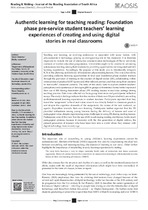| dc.contributor.author | Moodley, Trevor | |
| dc.contributor.author | Aronstam, Shelley | |
| dc.date.accessioned | 2018-05-24T07:10:50Z | |
| dc.date.available | 2018-05-24T07:10:50Z | |
| dc.date.issued | 2016 | |
| dc.identifier.citation | Moodley, T. & Aronstam, S. (2016). Reading & Writing 7(1): a129. | en_US |
| dc.identifier.issn | 2079-8245 | |
| dc.identifier.uri | http:// dx.doi.org/10.4102/rw. v7i1.129 | |
| dc.identifier.uri | http://hdl.handle.net/10566/3728 | |
| dc.description.abstract | Teaching and learning, an evolving endeavour, is associated with many factors, with
advancements in technology, playing an ever-growing role in the classroom. It is therefore
important to include the use of interactive communication technologies (ICTs) in university
curricula of teacher education programmes. Universities ought to be creative in advancing
autonomous learning among their students by providing opportunities for integrated and rich
learning experiences. Accordingly, the purpose of this study was to intentionally integrate
ICTs in the planning and delivery of foundation phase reading lessons. This was achieved by
providing authentic learning opportunities to final year foundation phase student teachers
through the provision of training in the creation of digital stories (DS), collaborating within
communities of practice (COP) (peers and other relevant parties), and then using their creations
in ‘real-world’ classroom contexts. The aims of this study were to explore student teachers’
perceptions and experiences of developing DS in groups with minimal formal initial input and
their use of DS during foundation phase (FP) reading lessons in real-class settings during
teaching practice. Data were collected via focus group interviews and participants’ reflection
essays. The study’s findings indicate that the creation of their own DS provided rich, rewarding
multidimensional learning experiences to student teachers. Participants reported that they
found the ‘assignment’ to be of real value, since it was directly linked to classroom practice,
and despite the cognitive demands of the assignment; the nature of the task nurtured, an
agentic disposition towards their own learning. Participants further reported that the DS
provided enthusiasm among young learners during the delivery of lessons and were of
pedagogical value, despite experiencing some challenges in using DS during reading lessons.
Participants were of the view that the use of DS in advancing reading and literacy holds much
pedagogical promise, because it resonates with the this generation of digital natives, the
present generation of learners who have been born into a world where they interact with
digital technology from an early age. | en_US |
| dc.language.iso | en | en_US |
| dc.publisher | AOSIS | en_US |
| dc.rights | © 2016. The Authors.
Licensee: AOSIS. This work
is licensed under the
Creative Commons
Attribution License. | |
| dc.subject | Teaching and learning | en_US |
| dc.subject | Interactive communication technologies (ICTs) | en_US |
| dc.subject | Authentic learning | en_US |
| dc.subject | Teaching reading | en_US |
| dc.subject | Foundation phase | en_US |
| dc.title | Authentic learning for teaching reading: Foundation phase pre-service student teachers’ learning experiences of creating and using digital stories in real classrooms | en_US |
| dc.type | Article | en_US |
| dc.privacy.showsubmitter | FALSE | |
| dc.status.ispeerreviewed | TRUE | |
| dc.description.accreditation | DHET | |

